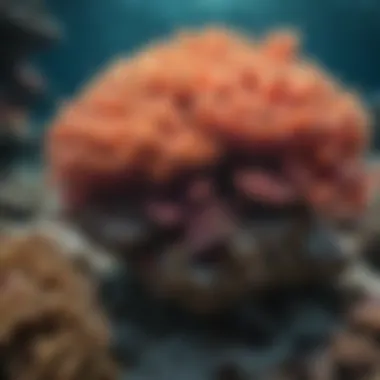Exploring the Enchanting Islands of The Bahamas


Intro
The Bahamas is a group of stunning islands located in the Caribbean. It consists of 700 islands and cays, all of them vibrant in their unique ecological and cultural aspects. The complex geography is home to white sandy beaches, crystal-clear waters, and rich marine life. This article seeks to illuminate the characteristics of these islands while engaging young readers in exploring this opulent region of our world.
Nature Topic Overview
The natural beauty of The Bahamas cannot be overstated. Situated between the Atlantic Ocean and Caribbean Sea, the islands create diverse environments. From large mangrove forests to coral reefs, each ecosystem matters not only in providing habitats but also in protecting the islands from strong winds. Children will discover how everything plays a role in nature's web.
Key Points of Exploration
- The variety of islands and cays varies significantly.
- Includes species unique to the regions of the islands.
- Studies will cover issues like conservation and environmental sustainability.
Gathering knowledge about the islands is vital for everyone. The more you learn about one of the most beautiful archipelagos on the planet, the more it instills a desire to care for and protect its wonders.
Fun Facts and Trivia
- Did you know that The Bahamas has over 200 species of fish? This makes it a top spot for snorkelers and divers.
- The capital city, Nassau, was originally a pirate haven in the 18th century.
- The islands featured in the famous James Bond movie "Thunderball" draw visitors every year.
Visual aids can help illustrate these exciting facts, making learning fascinating. Maps, colorful images, and motion graphics could significantly capture their attention.
Wildlife Explorations
The ecological diversity of The Bahamas supports numerous species. There are sea turtles, rays, and a variety of birds like the Bahama Parrot, which is unique to these islands. Each species contributes greatly to its surroundings.
More facts about wildlife:
- The reefs are filled with over 60 species of corals.
- Local biodiversity includes the endangered Andros Island Iguana.
Children can dig deeper by conducting quizzes or puzzles about the Bahamian species they encounter in their learning.
Environmental Awareness
Preserving the delicate balance of the environment is crucial. Pollution and climate crr, influences from neighboring countries, disrupt natural habitats. Ensuring healthiness of such environments means motivating the young generation to act.
Tips for Kids: Remember to always recycle, use less plastic, and support local conservation efforts.
DIY Nature Activities
Hands-on activities are excellent for small children. One idea is creating a treasure map leading them to the wonders of The Bahamas. This can be an imaginative but educational experience to draw out accurate geology and marine resources of the region.
Here is where education meets creativity:
- Craft coral reefs using cardboard, paint, and thatcan spark their imagination about marine life.
- Encourage nature walks. While exploring, children spotted unusual plants or animal signs, skills for sensitivity.
Prologue to The Bahamas
The Bahamas, an archipelagic jewel in the Atlantic Ocean, presents an opportunity to understand both its geographical significance and its intricate historical tapestry. This introduction serves as a gateway for readers to explore the vibrant landscapes and rich cultures of this island nation. By diving into these key elements, one grasps not only the beauty of the islands but also their essential roles in trade, tourism, and ecology.
Geographical Location
The geographic positioning of The Bahamas is unique. Situated southeast of the United States and north of Cuba, this extensive collection of islands lies in the Caribbean. Spread over 100,000 square miles, the archipelago consists of around 700 islands and over 2,400 cays. This strategic location shapes its climate, biodiversity, and interaction with neighboring regions. The Clear turquoise waters, sandy beaches, and varying topography contribute significantly to both ecological diversity and tourism. Notably, the islands lie between the coordinates of approximately 20° N and 25° N latitude.
Moreover, the clear delineation of the Bimini Islands from the rest of the archipelago connect The Bahamas, both culturally and economically, to the United States. The islands have advantageous trade routes open to shipping from North America and the wider Caribbean, enhancing their importance in regional economics.
Accurate knowledge of this geographical location will assist young readers in understanding how the natural features of the islands influence settlements, lifestyles, and various industries within The Bahamas.
Brief History
Tracing back to its historical roots, The Bahamas have a rich tapestry that significantly impacts its current identity. Initially inhabited by the Lucayan people, the first European sighting belongs to Christopher Columbus in 1492. His arrival initiated a wave of exploration and colonization by the Spanish, altering the course of the islands' development.
During the 17th century, various European powers vied for control, leading to the cultivation of a plantation-centric economy reliant on enslaved Africans. Ultimately, the islands became a haven for loyalists fleeing from the American Revolutionary War. This historical convergence creates a multidimensional cultural identity today, marked by storytelling, music, and arts.
In 1973, The Bahamas gained independence from British colonial rule, which marks a pivotal moment in its history. With the newfound autonomy, the islands started carving an authentic national status that echoed through its governance, economics, and cultural expressions. The exploration of this history is vital as it frames current societal dynamics, further enhancing our comprehension of The Bahamas.


Holistic comprehension of both the geography and history facilitates greater appreciation for the modern context of The Bahamas.
This section sets the stage for subsequent topics that highlight various facets of The Bahamas. From the total count of islands to unique cultural elements, each facet contributes to a broader understanding of this remarkable archipelago.
Total Number of Islands
The topic of the total number of islands in The Bahamas is crucial in understanding this remarkable archipelago. Each isle adds distinct character and attractions, influencing tourism, culture, and the environment. By realizing the sheer number of islands and cays, readers can appreciate the rich biodiversity and diverse human activities that flourish across this nation.
Count of Main Islands
There are about 30 main islands in The Bahamas. Each island has its own unique features and appeal. The most acknowledged are:
- New Providence: This island houses the capital city, Nassau. It is lively and serves as a hub for commerce and tourism.
- Grand Bahama: This island draws many visitors for its stunning beaches and resorts.
- Abaco Islands: Known for sailing and natural beauty, these islands are popular with numerous wildlife as well.
These main islands offer visitors numerous activities. From exploring historical sites to enjoying beach days, there is something for everyone. Understanding how many islands exist enriches one’s experience of discovering them.
Count of Smaller Cays
Beyond the main islands, The Bahamas features over 700 cays. Cays are small and sandy islands that usually ring with crystal blue waters. These are not to be ignored because they are significant in many ways.
Some of these cays include:
- Exuma Cays: A number of small islands ride this beautiful area, known for stunning waters and swimming pigs!
- Andros Cays: These are unwritten adventures that attract eco-tourists looking for serene atmospheres.
The smaller cays provide natural harbors and serene settings. They also offer habitats for varied marine life, enhancing understanding of coastal ecosystems. The sum of main islands and smaller cays in The Bahamas leads to an appreciation of the complex relationship between people and nature.
Major Islands in The Bahamas
The Bahamas is known for its beauty and diversity among its several islands. These islands are not just scenic. They play crucial roles in economics, culture, and tourism. Each major island harbors unique traits and characteristics.
New Providence
Capital City: Nassau
Nassau, the capital city of The Bahamas, stands as a vibrant center for the nation. Its historical significance is evident in its colonial architecture and rich cultural diversity. Residents and visitors can discover traces of past epochs that influence daily life even today. Additionally, Nassau serves as the main entry point for many travelers, making it key in enhancing the island's economy through tourism.
A primary characteristic of Nassau is its lively atmosphere. From bustling marketplaces to quiet, sun-drenched beaches, it welcomes many. Visitors experience local life firsthand and enjoy authentic Bahamian cuisine. However, attracting such attention comes with its challenges surrounding overcrowding during peak seasons. Balancing tourist interactions with local traditions can be complex.
Key Attractions
Key attractions in Nassau like Atlantis Paradise Island and the National Art Gallery of The Bahamas can be dazzling to all ages. These sites contribute to the island's image as a holiday hotspot. Activities range from water parks to art exhibitions. Such diversity ensures every visitor finds something suited to their preference.
Moreover, areas such as Junkanoo Beach showcase local celebrations while reseller shops provide a taste of Bahamian handicrafts. However, noteworthy sites may become congested, influencing overall enjoyment. Having a strategy or plan could alleviate possible inconvenience during peak times.
Grand Bahama
Popular Destinations
Grand Bahama offers several popular destinations. The island is known for resorts, enchanting beaches, and noteworthy establishments like Port Lucaya Marketplace. These areas emphasize the compatibility of relaxation and excitement and ensure visitors choose how to spend their leisure time.b Also, nature trails and beautiful vistas present outdoor experiences that reflect The Bahamas’s natural charm. Despite its attractions, some areas can feel commercial or tourist-dominant. It’s essential for visitors to engage with local life too, finding balance in their adventure.
Natural Reserves
Natural reserves provide another highlight in Grand Bahama. The Lucayan National Park is a crucial zone for native wildlife and a showcase of lush, untouched areas. Exploring nature here is essential for understanding The Bahamas' rich biodiversity.
Besides scenic tours, these reserves have educational components, helping visitors learn more about the environment. Regrettably, weather conditions can affect access to these nature sites, hindering some visitors' experiences.
Abaco Islands
Cultural Significance
Culturally, the Abaco Islands hold considerable importance in The Bahamas. They are known for their diverse population and traditional boat-building communities. These islands reflect the country’s evolution through their art, music, and social practices. The people lovingly preserve traditions, allowing visitors to witness history in a dynamic way. However, accessing remote areas for genuine experiences can be more challenging, yet it's often worth the effort.
Tourism Highlights
Tourism highlights on the Abaco Islands help drive economic growth. Ferry services connect various cays and allows tourists to explore the region. Destinations such as Hope Town feature attractive lighthouses and picturesque views, appealing to both leisure and adventure seekers.
Each journey through the Islands shapes collective tourist experiences as they connect aimed encounters with locals, hidden gems in crafts, or engaging storytelling about maritime folklore. Still, interaction may sometimes lead to misunderstandings, emphasizing preparation and good local insight are vital to deeper connections.
Environmental Diversity
Environmental diversity is central to understanding The Bahamas. The archipelago's range of ecosystems shapes its landscapes, influences wildlife, and is essential for conservation efforts. Diversity in environments ensures various flora and fauna thrive, creating a rich tapestry of life. This section details the unique ecosystems and the plants and animals they harbor, emphasizing their benefits.
Unique Ecosystems
Coral Reefs


Coral reefs in The Bahamas are critical. They act as barriers, protecting the shorelines from erosion by waves. Their allure and vibrancy make coral reefs a popular attraction, both for visitors and researchers. Corals provide essential habitats for many marine organisms, showcasing the interconnectedness of ocean life. The diversity of species within shores of natural coral reefs is impressive. However, they face threats, including climate change and pollution.
Key characteristics of coral reefs:
- Protection to coastlines
- Habitat for marine life
- Support fisheries
Despite their benefits, coral reefs are at risk due to rising sea temperatures and acidification. Protecting these ecosystems is vital, which means both awareness and action are needed in the management of these areas.
Bushlands
Bushlands embody a different yet equally important ecosystem. These areas consist of shrubs, trees, and diverse ground cover. Bushlands play various roles, such as preventing soil erosion and providing habitats for terrestrial species. They create buffers around coastal ecosystems, thus contributing to their overall health. Increased biodiversity is a metric used to measure the health of the bushlands. This feature allows for important demonstrated support for a numerous types of wildlife.
Key characteristics of bushlands:
- Erosion prevention
- Diverse habitat for wildlife
- Climate moderation effect
Bushlands are not just points annexed in between developed areas. They let plants thrive, allowing for a stronger, thicker vegetation in drier years. Just like with coral reefs, the protection of such environments is requisite for future generations.
Flora and Fauna
Native Plants
Native plants sustain the ecosystems of The Bahamas. They contribute to soil stability and support both small animals and larger wildlife. The unique species adapting to the island environments indicates a long evolutionary dance, achieving incredible excellenct adaptation over time. Retaining these native plants offers significant resilience to the community as they cope with environmental changes.
Key characteristics of native plants:
- Soil health support
- Wildlife food sources
- Erosion creating benefits
The importance of native plants is immeasurable. Make any adjustment that threatens these unique species can disrupt intricate food webs. Therefore, awareness of the necessary trades of these plants is of utmost importance.
Wildlife Species
Wildlife species of The Bahamas are diverse and specialized. The islands support marine animals like dolphins, sea turtles, and various fish. Terrestrial wildlife, including birds and reptiles, contribute to the charm of this archipelago. Each species provides vital roles in ecosystems. Thus, verification of ecosystems supports these habitats sustinably.
Key characteristics of wildlife species:
- Biodiversity representaing richness
- Pollution counters of sensitive ecosystems
- Importance to education and research
Protecting these species not only prevents loss but provides educational opportunities for future generations. Thus, mutual recognizing stays continuing iss considered.
Important note: It remains vital to promote awareness and support for biodiversity. It aids greatly in the protection of diverse ecosystems across The Bahamas.
Cultural Aspects
Cultural aspects of The Bahamas are vital in understanding the identity of this archipelago. The rich tapestry of local traditions and communities reflects the influences of the indigenous peoples and colonial history. This section explores how culture binds the people of The Bahamas, providing insights into their way of life, art, and communal values.
Local Communities
Local communities across The Bahamas are made up of diverse cultures and backgrounds. The populace primarily descends from African ancestors, who have strongly influenced the music, dance, and culinary practices of the region. Diversity continues to thrive as tourism brings exposure to various global cultures.
The deep sense of community is evident in the day-to-day life. Families often gather for meals that feature local dishes, such as conch fritters and baked mac and cheese. It is not uncommon for community events to include traditional storytelling sessions, where elders pass down folklore and values to the younger generation. Here are some elements of local communities:
- Generational Ties: Children learn customs and traditions from their elders.
- Community Spirit: Neighbors often support one another, especially during festivities or challenges.
- Shared Experiences: Events celebrate Bahamian identity and heritage collectively.
In The Bahamas, community is not just a concept but a way of life. Living together, sharing stories, and passing down customs keep traditions alive.
Festivals and Traditions
Bahamian festivals are a colorful and lively expression of culture. These celebrations allow residents and visitors to immerse in the unique traditions and history of the islands. One of the most notable events is Junkanoo, a vibrant parade featuring rhythmic music, elaborate costumes, and energetic dancing. Held on Boxing Day and New Year's Day, this festival embodies national pride and creativity.
In addition to Junkanoo, the people also celebrate:
- The Bahamas Independence Day: Memorable events on July 10 that honor the nation’s history.
- Various Church Festivals: Set the tone for spirituality and fellowship within local communities.


Traditions play a big role in how the Bahamian culture expresses joy, reflects on history, and strengthens community bonds. These festivals not only highlight their artistry but also reinforce the collective identity of the Bahamian people.
Celebrating the cultural aspects of The Bahamas is essential as it fosters appreciation and understanding of this exciting locale.
Economic Significance
The economic contribution of The Bahamas is substantial, driven mainly by its unique geographical features. The islands are a key player in the Caribbean’s economy, matrixed with several industries generating income and jobs for many residents. Both tourism and agriculture are two core pillars serving the needs of local people while attracting foreign visitors.
Tourism Industry
Tourism is arguably the largest sector in the economy of The Bahamas. Millions of tourists flock to the islands every year, captivated by their natural beauty and cultural experiences. Major attractions include Nassau, Paradise Island, and Grand Bahama. Government reports often show thousands of visitors arriving yearly, particularly from North America.
Tourism provides diverse jobs, from hotel management to tour guiding. This influx drives demand for various products and services, stimulating local businesses. Duties like hospitality, food services, and recreational activities are key for the workforce development. Here are the crucial aspects:
- Economy Boost: Direct revenue generation through lodging, dining, and tours
- Employment: Job creation in numerous sectors
- Infrastructure Development: Roadworks and public services tied to tourist influx
Wages from tourism help support families. It enables better education and healthcare as people use their earnings in everyday life.
Fishing and Agriculture
Fishing is another key industry in The Bahamas. The surrounding waters house an incredible variety of marine life. Therefore, fishing sustains local food supplies and provides income for fishermen. Sustainable practices are important to maintain fish stocks and habitat.
Agriculture also plays its role, though less prominent than tourism or fishing. Crops like citrus fruits, vegetables, and sugarcane are grown for local consumption. These industries provide food security while ensuring a healthy economy.
Economic attributes of fishing and agriculture include:
- Food Supply: Essential products grown for the local market
- Income Generation: Money from dairying and butchery
- Culinary Traditions: Local ingredients shape Bahamian dishes
Both fishing and agriculture offer stability to the economy of The Bahamas. They support the culture and richness of the islands while sustaining the livelihoods of those who depend on nature's bounty.
The harmony between tourism, fishing, and agriculture creates a balanced economic strategy for the Bahamian islands.
Understanding these economic components helps appreciate not only the grandeur of The Bahamas but also the efforts made to encourage local communities to thrive fully.
Conservation Efforts
Conservation is vital to safeguard the diverse ecosystems, wildlife, and natural resources of The Bahamas. With its unique environment comprising stunning coral reefs and lush vegetation, protecting these areas ensures that future generations can enjoy and learn from them. Additionally, conservation efforts support local communities by promoting sustainable practices that have long-term benefits. A healthy environment directly influences local economies, particularly tourism and fishing which are cornerstones of The Bahamas' income.
Protected Areas
In The Bahamas, protected areas play a key role in conservation strategies. These include national parks, marine reserves, and wildlife sanctuaries designed to preserve indigenous species and habitats.
- Abaco National Park: This park safeguards a beautiful expanse of pink sand beaches and crucial habitats for wildlife, including the endangered Abaco parrot.
- Exuma Cays Land and Sea Park: This is a leading example of marine protected areas. It is essential in conserving coral reefs and other marine organisms while providing a sanctuary for various fish species.
- The Andros Island Blue Holes: Protecting these underwater features aids in biodiversity, sheltering rich ecosystems.
Establishing these protected areas not only ensures ecological balance but also acts as learning zones that raise public awareness about conservation. Collaborations between local government, NGOs, and international organizations effectively enhance the ranking of these areas against environmental threats.
Local Initiatives
Many local initiatives aim to foster environmental awareness and responsibility among residents and visitors. Community-led projects often involve interviews with families, schools, and fisheries. These exchanges build understanding and dedication towards conservation. Here are some examples:
- School Programs: Many educational institutions design curricular activities centered around the significance of biodiversity. Engaging children in outdoor activities cultivates respect for nature.
- Fishing Regulations: Implementing sustainable fishing practices ensures the preservation of marine life, helping avoid the depletion of fish populations.
- Beach Clean-ups: Local volunteers frequently participate in beach clean-up events to promote environmental responsibility. Such actions encourage community involvement in ddemonstrating a commitment to keeping nature unspoiled.
The End
Summary of Insights
Throughout the discussion, we covered several specific facets that define The Bahamas:
- The vast number of islands and cays offering a rich variety of ecosystems that nurture a multitude of flora and fauna.
- Prominent islands like New Providence and Grand Bahama are not only scenic but also brimming with historical and cultural vibrancy.
- The influence of local communities gives insight into enduring traditions, fostering a deep sense of identity.
- Economic aspects, notably tourism, play a crucial role in shaping the islands’ future and ensuring their sustainability. These insights affirm that The Bahamas stands as a site of both wonder and significance.
Understanding these elements enables young readers and families to appreciate the delicate balance of human activity and environmental needs immersed in the islands’ beauty.
Encouragement for Exploration
As we wrap up our exploration, it's imperative to foster a spirit of curiosity and investigation among the readers, especially the little ones. The Bahamas offers numerous opportunities for adventure. Families are encouraged to explore:
- The exciting wildlife sanctuaries to observe unique species in their native habitats.
- Natural parks that showcase the beauty of coral reefs.
- Historical landmarks that impart stories of the past.
Whether it’s diving in the crystal-clear waters or immersing in the vibrant local culture, every adventure in The Bahamas is a chance for education. Encourage a thorough exploration that will not only enlighten young minds but also instill a profound appreciation for our world’s magnificent ecological diversity and cultural richness. From craft markets to explorers' trails, The Bahamas can be a classroom, playground, and sanctuary all in one. Remember, exploration cultivates growth and expanded knowledge.
Surely, with a guided hand and an open heart, The Bahamas can be a delightful adventure for anyone willing to engage with its landscapes and communities.







